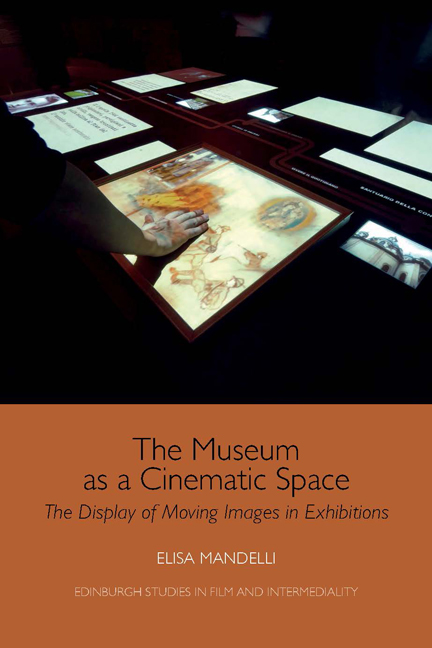Book contents
- Frontmatter
- Contents
- List of Figures
- Acknowledgements
- Preface
- Introduction
- Part I Between History and Modernity: Films in Exhibitions in the Twentieth Century
- Part II The Museum as a Cinematic Space: Museums and Moving Images in the Twenty-first Century
- 5 From the Museum Experience to the Museum as an Experience
- 6 Audio-visuals in Exhibitions
- 7 The Museum and its Spectres
- 8 A Walk through Images
- 9 New Interpretations of the Movie Theatre
- 10 Touching Images
- Conclusions
- Bibliography
- Index
9 - New Interpretations of the Movie Theatre
from Part II - The Museum as a Cinematic Space: Museums and Moving Images in the Twenty-first Century
Published online by Cambridge University Press: 24 October 2019
- Frontmatter
- Contents
- List of Figures
- Acknowledgements
- Preface
- Introduction
- Part I Between History and Modernity: Films in Exhibitions in the Twentieth Century
- Part II The Museum as a Cinematic Space: Museums and Moving Images in the Twenty-first Century
- 5 From the Museum Experience to the Museum as an Experience
- 6 Audio-visuals in Exhibitions
- 7 The Museum and its Spectres
- 8 A Walk through Images
- 9 New Interpretations of the Movie Theatre
- 10 Touching Images
- Conclusions
- Bibliography
- Index
Summary
Maeve Connolly has noted a widespread tendency among artists to produce, inside art venues such as exhibition galleries or pavilions, what she calls ‘cine-material installations’, that is, works that recreate the architecture of cinema. These artworks do not limit to create ‘black-boxes’ inside the gallery space, but explore and elaborate more radically on the structure of movie theatres. According to Connolly, the reference to the cinema as a venue for collective viewing enables an investigation of the reception of contemporary art. She stresses that, by evoking a different viewing context, art rethinks and reconfigures its relationship with its own viewers or public:
[I]t is … possible to identify a greater emphasis on the collective and social dimensions of reception, to the extent that cinema may even be understood specifically for its historical associations with an ideal public sphere. In other words, cinema history (rather than film theory) seems to hold an appeal for some practitioners because it may offer models or prototypes for the community.
Designing their works on the model of the architectures of movie theatres, artists explore the possibility of restoring a social space within the gallery, in a context where also film consumption has become more and more an individual and solitary practice. Erika Balsom argues that moving-image installations (part of what she calls ‘othered cinema’) draw the attention back to the social and shared dimension of reception:
[T]he othered cinema evinces a distinct emphasis on cinema as a public institution throughout its many facets. The museum and gallery emerge as public sites of spectatorship in an era marked by individual, domestic viewing, while many artists take up questions of collectivity, sociality, and publicity in their work.
In particular, in Balsom's view, installations of this kind are charged with a sense of nostalgia for the cinema not only in terms of its material support, the film reel, but also as a public space, a site of relationality now gradually replaced by forms of individual viewing. The reference to forms of fruition historically associated with the cinema is therefore associated with the role of public sphere that the latter has assumed since its origins.
- Type
- Chapter
- Information
- The Museum as a Cinematic SpaceThe Display of Moving Images in Exhibitions, pp. 115 - 123Publisher: Edinburgh University PressPrint publication year: 2019



